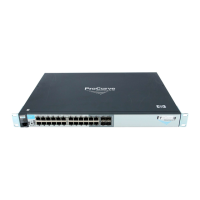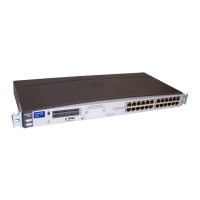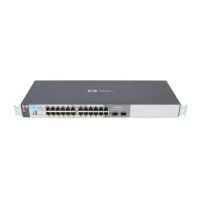Port Trunking
Trunk Group Operation Using LACP
Trunk Group TrkX: This port has been manually configured into a static LACP trunk.
Status Name Meaning
Trunk Group Same as Port Number: The port is configured for LACP, but is not a member of a port trunk.
Port Status Up: The port has an active LACP link and is not blocked or in Standby mode.
Down: The port is enabled, but an LACP link is not established. This can indicate, for example, a port that
is not connected to the network or a speed mismatch between a pair of linked ports.
Disabled: The port cannot carry traffic.
Blocked: LACP, spanning tree has blocked the port. (The port is not in LACP Standby mode.) This may
be due to a (brief) trunk negotiation or a configuration error such as differing port speeds on the same
link or trying to connect the switch to more trunks than it can support. (See the table on page 12-5.)
Note: Some older devices are limited to four ports in a trunk. When eight LACP-enabled ports are
connected to one of these older devices, four ports connect, but the other four ports are blocked.
Standby: The port is configured for dynamic LACP trunking to another device, but the maximum number
of ports for the Dynamic trunk to that device has already been reached on either the switch or the other
device. This port will remain in reserve, or “standby” unless LACP detects that another, active link in the
trunk has become disabled, blocked, or down. In this case, LACP automatically assigns a Standby port,
if available, to replace the failed port.
LACP Partner Yes: LACP is enabled on both ends of the link.
No: LACP is enabled on the switch, but either LACP is not enabled or the link has not been detected on
the opposite device.
LACP Status Success: LACP is enabled on the port, detects and synchronizes with a device on the other end of the
link, and can move traffic across the link.
Failure: LACP is enabled on a port and detects a device on the other end of the link, but is not able to
synchronize with this device, and therefore not able to send LACP packets across the link. This can be
caused, for example, by an intervening device on the link (such as a hub), a bad hardware connection,
or if the LACP operation on the opposite device does not comply with the IEEE 802.3ad standard.
LACP Notes and Restrictions
802.1X (Port-Based Access Control) Configured on a Port. To main-
tain security, LACP is not allowed on ports configured for 802.1X authenticator
operation. If you configure port security on a port on which LACP (active or
passive) is configured, the switch removes the LACP configuration, displays
a notice that LACP is disabled on the port(s), and enables 802.1X on that port.
ProCurve(config)# aaa port-access authenticator b1
LACP has been disabled on 802.1x port(s).
ProCurve(config)#
12-21
